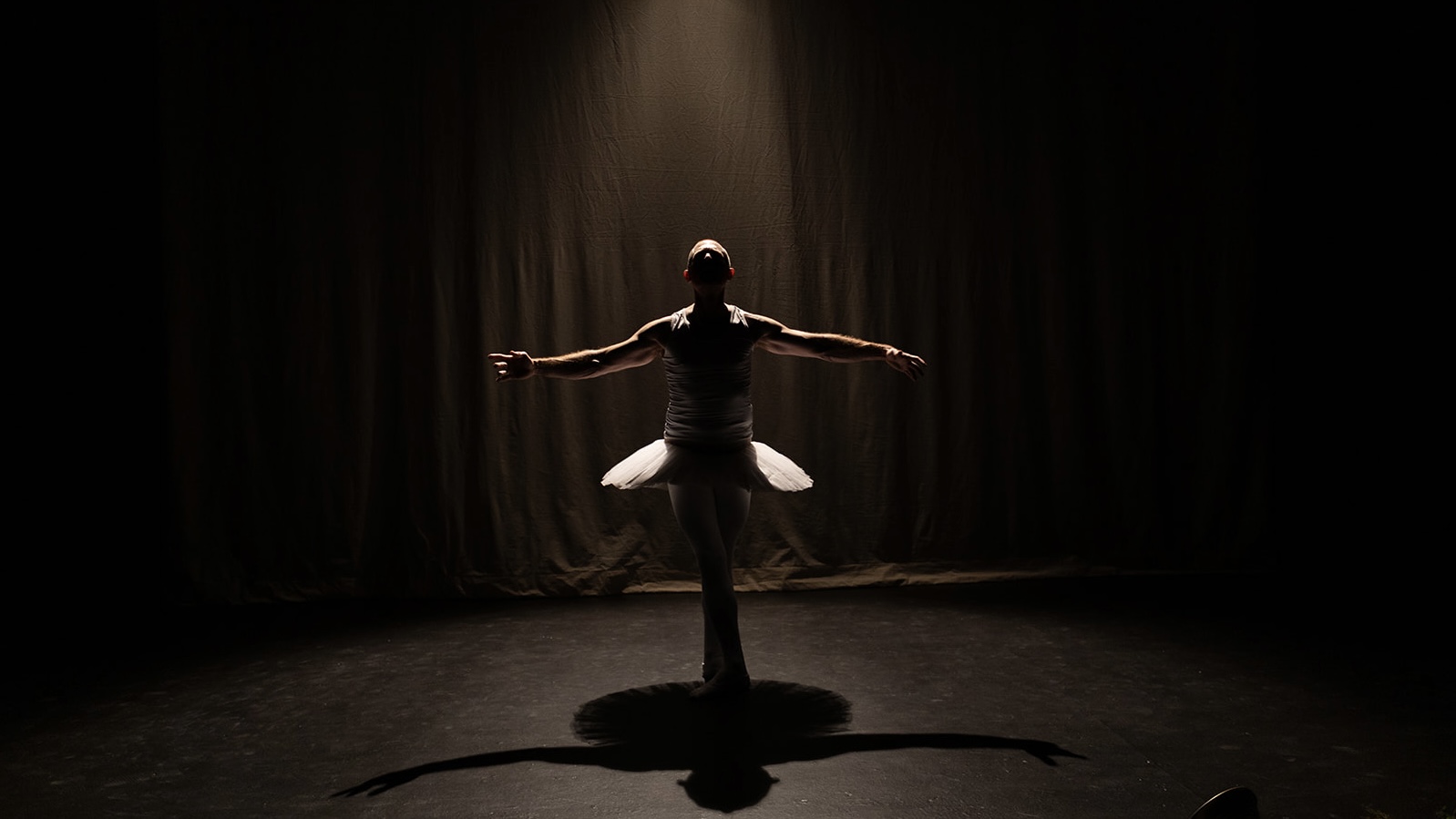Taking a dive with Philadelphia Dance Projects’ SCUBA is one of the serendipitous pleasures of the Philadelphia dance scene each year. The current stop on their four-city tour brought onto the radar screen companies from San Francisco, Seattle, and Minneapolis to join Philly’s Nichole Canuso in an eclectic evening of performances at Temple’s Conwell Theater. That the works were largely excerpts of longer pieces was their shared limitation.
The program began with a mythological pre-history of the Maenads, the female followers of Dionysius, as Erica Badgeley, in Seattle-based Elia Mrak’s erica, transformed a fully-lit theater and house into a place both sacred and wild. Costumed in a white chiton-style loose dress with a more contemporary cut (think H&M) to reveal her lower legs, Badgeley first emerged on stage for a half-hour as the audience gathered. She stood by an enigmatic hourglass of soundless sifting sand, scrutinizing each audience member with a wan smile and wide-eyed curiosity, shuddering and shaking, quixotic to our gaze. (After the performance she told us this was a standing warm-up, more mundane than it appeared).
erica is a title that embodies the dancer as the soloist becomes the dance. And what a dance of pure pleasure this was, with Badgeley exploring in directional runs, walks and rolls every meter of the stage as if each were a source of newfound sights, sounds and smells. Starting with a whooping sound, she suddenly leapt backwards into the air, gleefully defying laws of forward motion and our expectations of linear movement, all the while happily emitting sounds of effortful breathing and gazing into the audience’s eyes to transmit her joy. Her gyroscopic turns and spins included full body rolls on the floor that marked out a circle of space. It may have been her ecstatic repetitions and dervish-like commitment that became our ultimate pleasure, however passive we may have felt in her presence.
I’m afraid I was a bit lost within The Tent Has Been Pulled Down by Supergroup, a Minneapolis-based performance collaboration of Erin Search-Wells, Sam Johnson and Jeffrey Wells. I was certainly not aided by their note that the piece “combines text that flows from and responds to the feminist blogosphere.” Due to speed, a lack of projection and speech directed to the back of the stage, their talking dances were a potpourri of the audible and often inaudible and encompassed inter-generational banter and musings. A few of these (ex. “boring is the new wabi sabi”) drew hearty laughs from some in the audience. Although the opening movement phrases—a series of body rotations that led to weighted, uninvited kicks to the backs and arm slaps to the torsos of fellow dancers—seemed ripe to partner with the appropriate text, the text itself never cohered for me, and the later movement proved insufficiently inventive to sustain interest. Yet the performers exuded a devil-may-care insouciance and winsome spirit reminiscent of the early years of Philly’s Headlong Dance Theater that won them many admirers in the Conwell audience. Maybe I had ventured into another generation’s tent without the requisite guidebook.
It wasn’t necessary to be informed that San Francisco’s Jose Navarette and Debby Kajiyama, together the NAKA group, had been perhaps the only artists outside Japan to observe and engage with the local people of Northern Japan after the 3.11 earthquake, tsunami and Fukushima nuclear disaster. Their excerpt from their much longer BAILOUT! or Can you picture this prophecy? The temperatures are too hot for me, was sufficiently riveting to stand alone. Yet, from the playbill, we know the full performance seeks to confront catastrophic environmental disaster. Kajiyama, petite with dark short hair, was costumed in a simple white top and rolled-up pants. In her opening duet she partnered with a microphone attached to a small portable amplifier. It was as if woman and machine had just been introduced. The microphone seemed to interrogate her body via knocks to her chest and slides off her arms, eliciting electronic sounds that offered a physical and psychological sound-wave map of Kajiyama. When the microphone probed the immediate space around her body I heard the clicks of a Geiger counter. She blew air, and like Neptune toying with the sea winds, a gale engulfed her, and she exited.
In the second segment, sounds of lapping water enveloped the stage. Navarette appeared in a slow, bent over walk, with a large bundle of bright red sweater fabric enveloping his head and upper body. He clasped it to his chest like a refugee clinging to a remainder of his past life. When he prostrated himself on the floor the fabric was unfolded to reveal a strange garment with two torsos joined in the middle by sleeves that extended 12 feet across the floor. Kajiyama then entered the upper body segment opposite Navarette and they began moving in ways that connected them, but that rarely achieved intimacy or contact. Each pulled, or tried to retreat or exit, never quite to succeed. Ominous sounds of surrounding water and tremolo violin provided a soundscape. There was a pause for some play as the red sweater arms were swung in a kind of Double Dutch pattern to the pleasant tinkling of a toy piano, accompanied by the only smiles from the two in the piece. After Kajiyama exited, Navarette returned to his state of huddled flesh and fabric, then he too left the stage. Let’s hope we’ll see the entire work come to Philadelphia to experience their larger vision.
Nichole Canuso previewed a segment of Midway Avenue whose full-length version will appear in FringeArts Philadelphia this May. Departing from her work of the past decade, Canuso has created a well-designed solo movement theater work of personal memoir, challenging herself to vary the ways she calls up memories of her childhood. Before she appeared on stage, she used masking tape to create a variety of shapes on the ground, shapes we later learn are part of the floor plan of the house she grew up in. Canuso’s mix of reminiscences included some striking scenes. A rapid recitation of household items (dropped ceiling, toaster) was paired with a similarly paced tossing off of abbreviated gestures. When looking through an imagined window, she delivered a report of a street scene, rendered undecipherable by her frenetic excitement. Knowing Canuso’s movement potential, I await more physical embodiment of her stories, which might well occur in the full-length piece.
Some elements of Midway Avenue seemed arbitrary as in an early repetition of phrases like “there’s a table,” or when she conjured a dead body in the house, connecting it to a lugubrious Chopin Prelude with an explanation of its premonition of death, followed by a remembrance of her own mother’s fear of her daughter’s death. Perhaps a larger challenge than form in memoir is the solipsistic nature of the enterprise, and the need to make the content both legible and succinct enough to spark and sustain audience interest.SCUBA National Touring Network for Dance, presented by Philadelphia Dance Projects, Conwell Dance Theater, March 14-15






